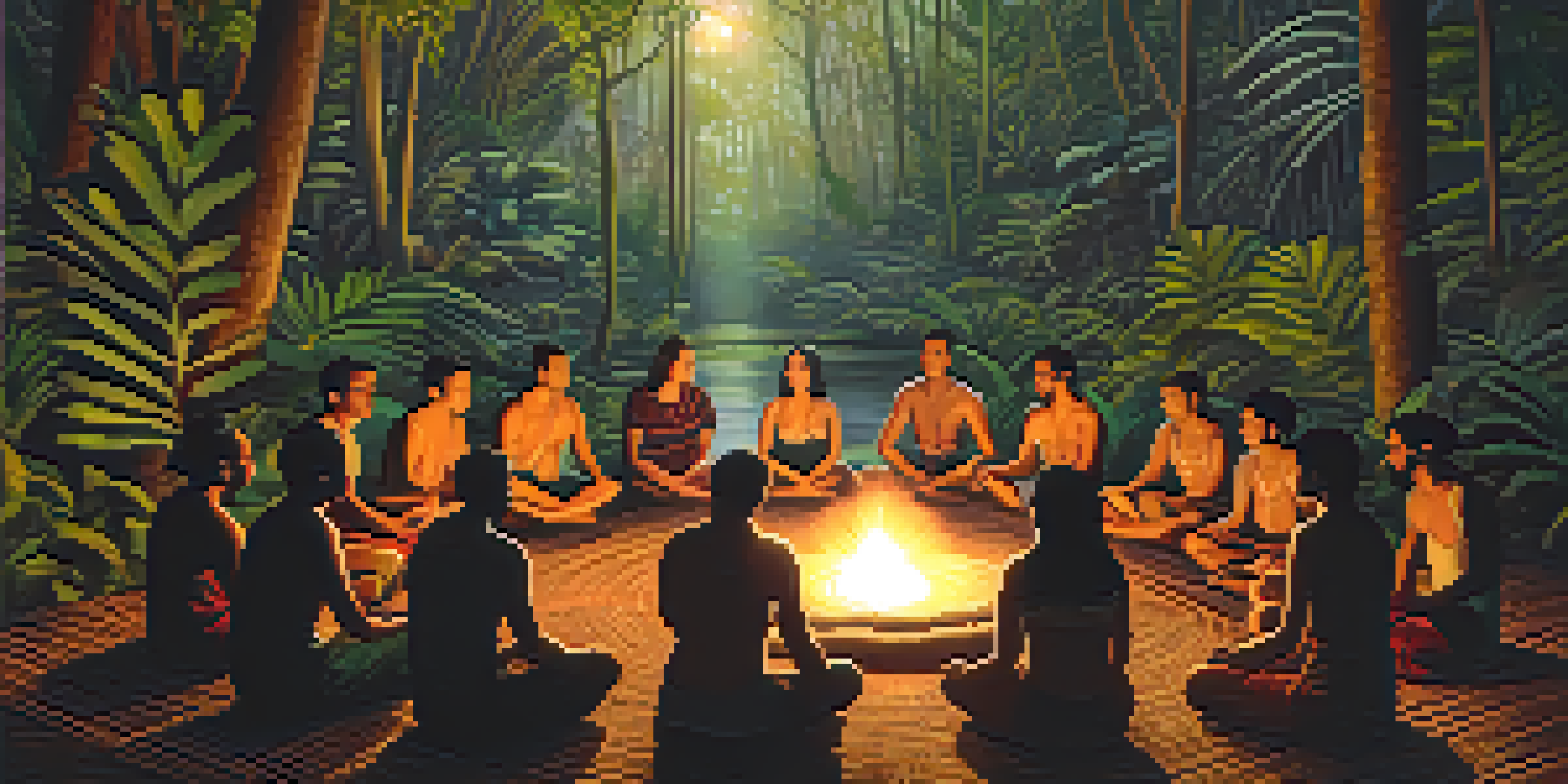The Role of Group Dynamics in Ayahuasca Ceremonies

What Are Ayahuasca Ceremonies?
Ayahuasca ceremonies are spiritual experiences rooted in traditional Amazonian practices. Participants often consume a brew made from the Ayahuasca vine and other ingredients, leading to profound emotional and psychological insights. These ceremonies are usually conducted in a group setting, where shared intentions and experiences can significantly influence the outcomes.
The journey of a thousand miles begins with one step.
The atmosphere during these ceremonies is often charged with collective energy, which can enhance individual journeys. Many participants report that the presence of others helps them feel supported and understood as they navigate their inner landscapes. This shared experience can foster a sense of community and belonging, which is essential for personal transformation.
In essence, Ayahuasca ceremonies are not just about the individual; they are communal experiences where group dynamics play a pivotal role. Understanding how these dynamics operate can help participants maximize their experience and deepen their connections with one another.
The Importance of Intention in Group Settings
Intention is a core element in any Ayahuasca ceremony, and its significance amplifies in a group context. When participants share a common intention, the collective focus can create a powerful synergy that enhances the experience for everyone involved. For example, if the group’s intention is healing, it can cultivate a supportive environment that encourages vulnerability and openness.

Moreover, individual intentions can also intertwine with those of the group, leading to rich interactions and shared insights. This interplay often results in a deeper understanding of personal and collective struggles, fostering empathy among participants. As stories and experiences are shared, individuals may find new perspectives and support that can help them on their healing journeys.
Intention Enhances Group Experience
Shared intentions during Ayahuasca ceremonies create a powerful synergy that deepens the collective healing process.
Ultimately, a clear and positive group intention can significantly shape the atmosphere of the ceremony. This shared purpose not only unites participants but also guides the energy of the experience, allowing for a more profound and transformative journey.
Influence of Group Size on the Experience
The size of the group in an Ayahuasca ceremony can greatly influence the dynamics at play. Smaller groups often allow for more intimate connections and personal sharing, which can enhance the sense of safety and trust among participants. In these settings, individuals may feel more comfortable expressing their emotions and experiences without fear of being judged.
We are all in this together, and we are all connected.
Conversely, larger groups can amplify the energy and intensity of the experience. The collective energy in a larger setting can create a powerful atmosphere that stimulates profound insights and emotional releases. However, this can also lead to feelings of anonymity, where individuals may struggle to connect on a personal level with others.
Finding the right balance in group size is crucial, as it can affect how participants engage with the ceremony. By understanding these dynamics, facilitators can create environments that best support the needs of their participants, whether they seek intimacy or shared intensity.
The Role of the Facilitator in Group Dynamics
Facilitators play a crucial role in shaping the group dynamics during Ayahuasca ceremonies. Their presence, guidance, and ability to read the room can significantly influence how participants interact and engage with the experience. A skilled facilitator can create a safe space where individuals feel comfortable exploring deep emotions and vulnerabilities.
Moreover, facilitators often set the tone for the ceremony, establishing guidelines and intentions that help align the group's energy. They can help participants navigate challenging moments, ensuring that the group remains cohesive and supportive throughout the journey. This ability to foster connection and understanding among participants is essential for a transformative experience.
Group Size Affects Dynamics
The size of the group can either foster intimacy or amplify energy, influencing how participants connect and engage.
Ultimately, the effectiveness of a facilitator can enhance or detract from the overall group dynamics. A compassionate, attentive facilitator can help create an environment that nurtures healing, connection, and personal growth for all participants.
Shared Vulnerability: Bonding Through Experience
One of the most profound aspects of Ayahuasca ceremonies is the shared vulnerability that often emerges among participants. As individuals confront their fears, traumas, and insecurities, they may find solace in the fact that others are experiencing similar challenges. This mutual vulnerability can create strong bonds among participants, fostering a sense of community and belonging.
When people share their stories and emotions, it opens the door for deep connections that can last well beyond the ceremony. These shared experiences can lead to friendships and support networks that provide ongoing encouragement and understanding. In many cases, participants leave the ceremony feeling a renewed sense of hope and connection with others.
This bonding through shared vulnerability not only enhances the individual experience but also strengthens the collective energy of the group. The emotional support found in these connections can be a vital component of the healing journey.
Cultural Context: Ayahuasca and Community
Understanding the cultural context of Ayahuasca ceremonies is essential to appreciating their group dynamics. In many indigenous cultures, these ceremonies are communal events that emphasize the importance of community and shared healing. Participants often come together with a sense of responsibility for each other's well-being, which can profoundly impact the energy of the experience.
This cultural emphasis on community can serve as a guiding principle for modern ceremonies as well. By fostering a sense of belonging and mutual support, participants can navigate their journeys more effectively. Many modern facilitators draw inspiration from these traditional practices, integrating communal elements into their ceremonies.
Facilitators Shape Group Dynamics
Skilled facilitators play a crucial role in guiding interactions and creating a safe environment for emotional exploration.
Ultimately, recognizing the cultural significance of Ayahuasca ceremonies can enrich participants' experiences. Understanding how community shapes the dynamics of these events can lead to deeper connections and more meaningful transformations.
Post-Ceremony Integration: The Group’s Role
The integration phase following an Ayahuasca ceremony is where much of the healing and understanding occurs. During this time, the group can play a vital role in helping individuals process their experiences. Sharing insights, feelings, and reflections within the group can foster a deeper understanding of personal journeys and collective themes.
Participants often find that discussing their experiences with others who shared the journey can provide clarity and validation. This process of integration can enhance the lessons learned during the ceremony, making them more applicable to everyday life. The supportive environment of the group can help individuals feel less isolated in their experiences, promoting healing and growth.

In many cases, ongoing connections formed during the ceremony can lead to support groups or community gatherings focused on integration. This continued support can be instrumental in helping participants navigate the challenges of their post-ceremony lives, ensuring that the benefits of the experience are not lost.